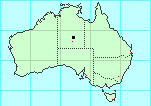
Common Name:
Delete this section if there is no common name.
Identification:
volant; male and female mesopterous
| body | 172 mm. |
| head | 10 mm.
width, 7 mm. |
| pronotum | 8 mm.
width, 6.5 mm. |
| mesonotum | 38 mm.
width, 65 mm. |
| metanotum | 15 mm.
width, 8 mm. |
| abdomen | 103 mm.
width, 9 mm. |
| tegmina | 22 mm.
width, 6 mm. |
| wings | 47 mm.
width, 47 mm. |
| ant. femora | 34 mm. |
| ant. tibiæ | 33 mm. |
| ant. tarsi | 11 mm. |
| med. femora | 27 mm. |
| med. tibiæ | 30 mm. |
| med. tarsi | 8 mm. |
| post. femora | 46 mm. |
| post. tibiæ | 42 mm. |
| post. tarsi | 10 mm. |
| antennæ | 35 mm. |
Female.
Body hoary grey to whitish, or brownish, where discoloured. Head with
two thick, acuminate, rugose horns, almost vertical, and subparallel,
and with several rows of tubercles.
Tegmina small, with brown veins and veinlets.
Wings perfect, but too small for flight; costal area with base pale,
and adjoining a large black spot, remainder with illdefined pale and dark
bars and blotches; membranous portion deep black, with about five narrow,
more or less irregular and disrupted transverse pale bars and some small
isolated spots uear the external margin.
Pronotum tuberculate, furrowed, and ridged.
Anterior femora stout, acutely triquetrous, the superior ridge with
four subequal, broad, forward-directed serrations, terminating
in acute spinelets. Mesonotum finely tuberculate in front and behind,
with some scattered spine-lets (two larger than the rest), on the disc.
Median femora with eight spinelets along inferior internal ridge, and one
near the middle of the external; internal ridge of median tibiæ
with three triangular spines, and one on the external near the joint,
besides the terminal spurs.
Hind femora with larger spines along the central line beneath, five small
spines along the inner lower ridge, and four minute ones on the external.
Abdomen stout, cylindrical to fifth segment, but gradually contracted
beyond.
Posterior margin of fourth segment with four short ridges, the
outer ones convergent, and the margin between thorn extended into a
foliate quadrilateral appendage
with rugose edges, and double mid-rib, 4 mm. long.
Subgenital lamina much exceeding the next two segments in length (24 mm.),
apex broad, subemarginate.
Cerci very short, scarcely exceeding anal segment.
Under side of abdomen with a double row of tubercles to sixth segment,
6 to 8 on each segment.
(Tepper 1905)
 About 80% of eggs are placed into sandy soil by the female,
with the remainder dropped.
About 80% of eggs are placed into sandy soil by the female,
with the remainder dropped.
Eggs take about 8-12 months to hatch.
The species appears to be cold tolerant, which makes sense considering
where they live, but obviously their growth is slowed considerably. In
a heated environment around 26°C, moults occur about every
fortnight. Males undergo 5 moults, females 7.
(Mark Hura, pers. comm. 2000)
Habitat:
Nymphs known to eat Acacia argyrophylla, A. brachybotrya
and A. victoriae. The adults are less fussy, they also eat
A. iteaphylla and, rarely Eucalyptus.
(Mark Hura, pers. comm. 2000)
Similar Species:
Rearing Notes:
Successfully reared by Mark Hura - with difficulty.
Note any suggestions for successful rearing.
For a stick insect with body length 172mm, to keep 2 adult females,
you need a cage at least 800mm high, 350mm deep and 350mm wide.
 Range:
Range:
W plateau, SA; known only from type locality
(not any more!)
Status:
It is not known if this species is endangered,
as there is insufficient sighting history.
References:
-
Balderson, J., Rentz,
D.C.F. and Roach, A.M.E. (1998).
in
Houston, W.K.K. & Wells, A. (1998) (eds)
Zoological Catalogue of Australia.
Vol. 23.
Archaeognatha, Zygentoma, Blattodea, Isoptera, Mantodea, Dermaptera,
Phasmatodea, Embioptera, Zoraptera.
Melbourne: CSIRO Publishing, Australia (ISBN 0643 06035 9).
pp. 347 - 376.
-
Tepper, J.G.O. (1905).
Insects collected in the North-western Region of South Australia Proper
by H. Basedow; with Descriptions of New Species of Mantidæ and
Phasmidæ, No. 2.
Transactions of the Royal Society South Australia, 29: 237-245.
-
Vickery, V.R. (1983).
Catalogue of Australian stick insects (Phasmida,
Phasmatodea, Phasmatoptera, or Cheleutoptera). CSIRO
Australian Division of Entomology Technical Paper, No. 20, 15 pp.
- Search Google for
Acrophylla cornuta,
or search Google Scholar for
Acrophylla cornuta.
Synonyms:
Copyright © 2000-2003
Peter Miller
This page was last changed 20-Sep-2006.
|

|

|
 About 80% of eggs are placed into sandy soil by the female,
with the remainder dropped.
About 80% of eggs are placed into sandy soil by the female,
with the remainder dropped.

 About 80% of eggs are placed into sandy soil by the female,
with the remainder dropped.
About 80% of eggs are placed into sandy soil by the female,
with the remainder dropped.
 Range:
Range: 
